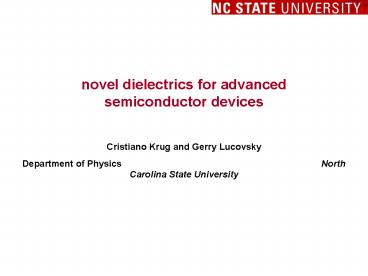novel dielectrics for advanced semiconductor devices - PowerPoint PPT Presentation
1 / 20
Title:
novel dielectrics for advanced semiconductor devices
Description:
engineering solutions ... chemical phase separation (CPS) in Zr silicate and ZrSiON alloys after 900 C annealing ... at 1000 C chemical phase separation into ... – PowerPoint PPT presentation
Number of Views:32
Avg rating:3.0/5.0
Title: novel dielectrics for advanced semiconductor devices
1
novel dielectrics for advanced
semiconductor devices Cristiano Krug
and Gerry Lucovsky Department of Physics
North Carolina State University
2
outline band edge states - nanocrystalline HfO2
and ZrO2 theory and
experiment
inherent
limitations
engineering solutions band edge states -
non-crystalline Zr and Hf silicate alloys
theory and experiment
inherent limitations
engineering solutions novel device structure
experimental result
proposed device
structures research plan
3
band edge states
nanocrystalline HfO2 and ZrO2
theory and experiment
inherent limitations
engineering solutions
4
theory -- crystal field and Jahn-Teller
term-splittings
model calculation - ZrO2 band
edge d-states
two issues can XAS detect mixtures of tetragonal
and monoclinic nano-crystallites? and
can mixtures account for range of defect
state energies in electrical measurements ?
5
nano-crystallite grains - different for different
processing Stefan Zollners results at Freescale
- XRD and SE
multiple features in T2g region are indicative of
mixture of monoclinic and tetragonal
by XRD
as-deposited MO-RPECVD
films by IR are monoclinic similar result for
ZrO2
6
theory -- crystal field and Jahn-Teller
term-splittings
model calculation - ZrO2 band
edge d-states
can XAS detect mixtures of tetragonal and
monoclinic nano-crystallites?
YES model predicts at least 4 features in T2g
band observed for reactive evaporation, but not
for MO-RPECVD
7
p-bonded d-states/defects at conduction band
edge in
absorption constant (e2) and conductivity (PC)
onset of strong optical absorption - lowest Eg
state -
optical band gap
optical band gap
model calculations indicate band edge defect
state is associated with a Jahn-Teller distortion
at internal grain boundary and is intrinsic to
nano-crystalline thin films
8
localized band edge J-T d-states
inherent asymmetry in transport and
trapping including BTIs
trap depth
0.5-0.8 eV, same state PC and
band edge abs.
Z . Yu et al., APL 80, 1975 (2002),
in Chap 3.4 - High-K dielectrics, M. Houssa
(ed), IOP, 2004.
9
crystal field and Jahn-Teller term-splittings
model calculation using Zr and O atomic states
can mixtures account for range of defect state
energies in electrical measurements ?
YES
C-F cubic
3x energy scale
0.5 - 0.8 eV
10
engineering solutions NEC solution
limit applied bias so that
injection into
band edge defect states is not
possible modify band tail states by alloying
with
divalent (MgO) or trivalent oxides (Y2O3) e.g.
Y2O3 in cubic zirconia introduces vacancies
random distribution gives cubic structure and
eliminates J-T term splittings,
but
evidence for absorption associated with
excitations to/from
midgap state
issue is this state electrically active ?
study has just been undertaken
11
VUV spectroscopic ellipsometry and UV-VIS
transmission term-spitting removed - but new
absorption band at 4.1 eV
sub-band-gap absorption - O vacancies Jahn-Teller
term-split d-states of nc-ZrO2
not in Y-Zr-O, but edge broadened
12
outline band edge states
non-crystalline Zr and Hf
silicate alloys
theory and experiment
inherent limitations
engineering solutions
13
IR results - GB Rayner - PhD thesis, NCSU
Si-O-1 group shoulder 950 cm-1
grows with increasing x in
as-films deposited changes
continuously with annealing in inert ambient,
Ar SiO2 features at 1068, 810 and 450 cm-1
sharpen up with increasing Tann
chemical phase separation
non-crystalline by XRD, but,
x0.23
nano-crystalline by TEM and EXAFS
14
comparison of extended x-ray absorption fine
structure and x-ray diffraction
crystallite size difference for x 0.25 and
x 0.5 from HRTEM x0.25, 3 nm x0.5,
10 nm
15
chemical phase separation (CPS) in Zr silicate
and ZrSiON alloys after 900C annealing
dE0.5 eV
n-c
CPS
doubly degenerate Eg feature in non-crystalline
Zr silicate alloys independent of alloy
composition after 900C anneal, chemical phase
separation and crystallization
Eg narrowed/shifted 0.5 eV in Zr silicate,
asymmetric in ZrSiON
16
statistical/mean field disruption of SiO2 network
11 representation
of silicate alloys
i) metal ions, Na1, Ca2, Y3, Zr4, etc..
disrupt network converting bridging Si-O-Si to
terminal Si-O1- group ii) number of terminal
groups valence of metal ion, 1 for Na, 2 for Ca,
3 for Y and 4 for Zr iii) connectedness of
network defined by shared corners, Cs between
SiO4/2 units iv) Cs 4 perfect 3 D network,
Cs 1,0 completely disrupted mixture of SinOm
molecular ions and metal ions
xo
cs
cs 0
rate of network disruption increases with
valence of metal ion
when normalized on a per/atom basis for x gt xo
for Cs 0, silicate is inverted and SinOm are
minority species
17
pseudo-ternary (SiO2)1-x-y(Si3N4)y(ZrO2)x alloys
remote plasma enhanced chemical vapor
deposition
(SiO2)0.4(Si3N4)0.25(ZrO2)0.35
as-deposited amorphous alloy significant Si
oxynitride bonding after anneal at 1000C
chemical phase separation into
SiO2,
nanocrystalline ZrO2 with N-bonding
18
pseudo-ternary (SiO2)1-x-y(Si3N4)y(ZrO2)x alloys
remote plasma enhanced chemical vapor
deposition
(SiO2)0.3(Si3N4)0.4(ZrO2)0.3
as-deposited amorphous alloy significant Si
oxynitride bonding after anneal at 1000C no
chemical phase separation and
self-organization encapsulating ZrSiO4 bonding
groups viable engineering solution, k9-10, EOT
to 0.7-0.8 nm
19
novel device structures
(one example)
experimental results for Ge-SiO2 no
preoxidation C-V is as good as the best discussed
by Saraswat of Stanford Univ. at Workshop on
Future Electronics 2005 two approaches i) 15
oxidation followed by plasma nitridation ii) grow
3-5 atomic layers of pseudo-morphic Si on Ge and
oxidize surgically to prevent Ge-O bond
formation use on-line AES this worked in
mid-late 80's, but was not followed-up
20
research plans device testing - ZrO2-Y2O3 and
atomically engineered ZrSiON alloys nitrided Ge
interfaces - two approaches nano-scale vertical
p-n junctions
(25 nm diameter!)
a precursor to
vertical MOS devices
(SRC patent application in
process)































